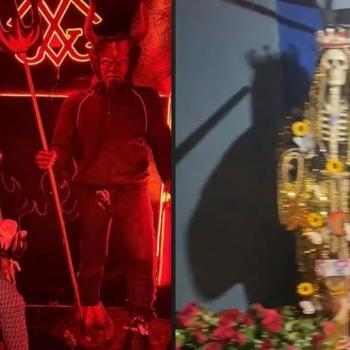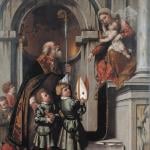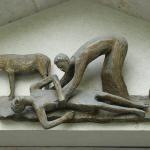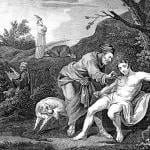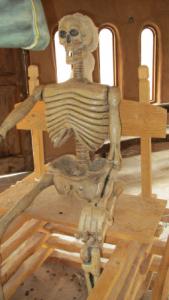
During the 19th century in the mountain towns of New Mexico and southern Colorado, Mexican-American Catholics personified death as a female figure known as Doña Sebastiana. Holy Week processions organized by the Penitentes, Catholic brotherhoods originating in Spain and known for their public displays of penance, included death carts with life-size effigies of the skeletal Doña Sebastiana. Along with acts of self-flagellation on the part of the Penitentes, the Grim Reapress symbolized not only the agony and death suffered by Jesus Christ on the cross but also the importance of a Holy Death (Santa Muerte).
In historical continuity with both her Spanish past and Mexican present, Doña Sebastiana was a female personifcation of death, typically marked by snow-white hair. In medieval Spain, the Grim Reaper was usually represented as the female Grim Reapress known as La Parca. However, it’s not only the Spanish Grim Reapress who was syncretized into the creation of Doña Sebastiana. Both her name and fact that she often stands in the death cart holding a bow and arrow suggest that Saint Sebastian fused with La Parca in the creation of Doña Sebastiana.
Saint Sebastian was a third-century Roman martyr who was shot full of arrows, but miraculously survived, according to legend. In two more extraordinary connections, the Roman saint is associated with both the concept of Holy Death and the Black Plague. Medieval Europeans correlated the apparent randomness with which the Plague struck to an indiscriminate rain of arrows from the sky. And since St. Sebastian was already associated with arrows, he became one of the most popular guardian saints during the Black Death. Of course, it was also at this same time in Europe that the figure of the Grim Reaper first emerged. Remarkably, the syncretism would seem to endure today in that the often homo-erotic depictions of St. Sebastian resonate in his special appeal to LGBT devotees.
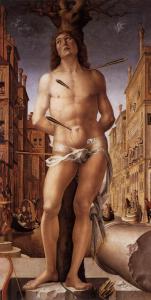
Beyond the larger history of Doña Sebastiana, the photos below are part of an intriguing story at the Catholic shrine at Chimayo, New Mexico, one of the most visited sacred sites in the U.S. and famous for its Holy Week pilgrimage, the largest of its kind in the country.
One of the local parish priests, a native of Barcelona, commissioned a local sculptor to create the death cart, which was installed in 2010 in an exhibit room attached to the Shrine of the Black Christ of Esquipulas. Already well into my research on Mexican folk saint, Santa Muerte, I was astounded to see the beautiful cart, along with a statue of Saint Francis Assisi on temple grounds. The saint, for whom Pope Francis is named, described death as a “sister.”
All praise be yours, my Lord, All praise be yours, my Lord,
for our Sister Physical Death
from whose embrace no mortal can escape.
Woe to those who die in mortal sin!
Happy are those she finds doing your most holy will!
The second death can do no harm to them.
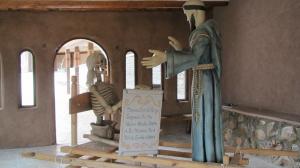
In the photo above, Sister Death holds a placard toward St. Francis’s outstretched arms, which reads:
“To die with the sacred joy of not having done harm to oneself nor to a single soul.”
These photographs are rare evidence that Sister Death, for the shortest of time, shared a sacred space with the patron saint of the poor. Just a short while after these photos were taken in March 2011, Doña Sebastiana and her cart were moved over to the nearby museum. Shrine officials feared the inevitable associations with her contemporary heiress, Santa Muerte.







